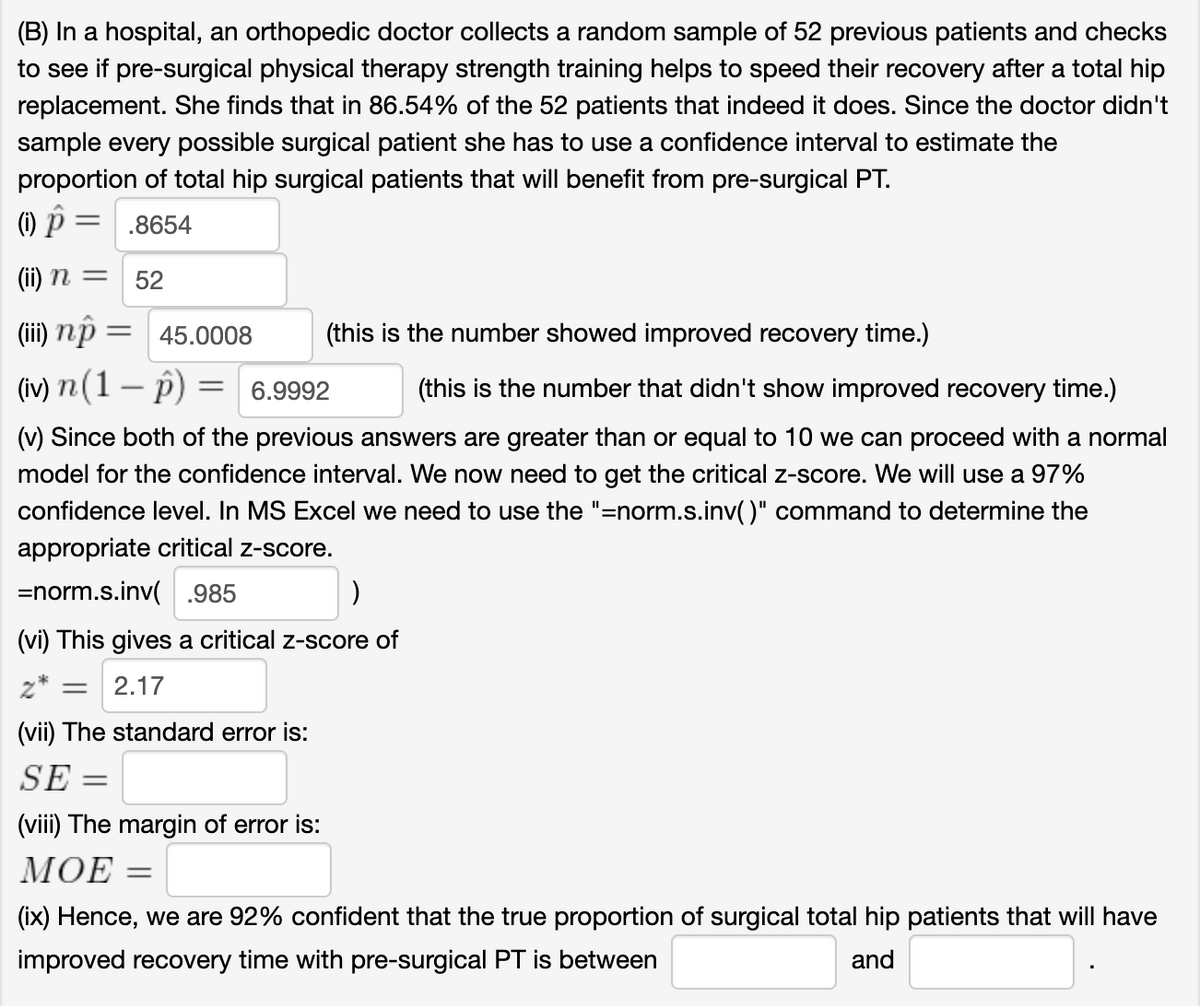(B) In a hospital, an orthopedic doctor collects a random sample of 52 previous patients and checks to see if pre-surgical physical therapy strength training helps to speed their recovery after a total hip replacement. She finds that in 86.54% of the 52 patients that indeed it does. Since the doctor didn't sample every possible surgical patient she has to use a confidence interval to estimate the proportion of total hip surgical patients that will benefit from pre-surgical PT. (1) p = .8654 (ii) n = 52 (ii) np = (iv) n (1 – p) 45.0008 (this is the number showed improved recovery time.) 6.9992 (this is the number that didn't show improved recovery time.) (v) Since both of the previous answers are greater than or equal to 10 we can proceed with a normal model for the confidence interval. We now need get the critical z-score. We will use 97% confidence level. In MS Excel we need to use the "=norm.s.inv()" command to determine the appropriate critical z-score. =norm.s.inv( .985 (vi) This gives a critical z-score of z* = 2.17 (vii) The standard error is: SE (viii) The margin of error is: МОЕ — (ix) Hence, we are 92% confident that the true proportion of surgical total hip patients that will have improved recovery time with pre-surgical PT is between and
(B) In a hospital, an orthopedic doctor collects a random sample of 52 previous patients and checks to see if pre-surgical physical therapy strength training helps to speed their recovery after a total hip replacement. She finds that in 86.54% of the 52 patients that indeed it does. Since the doctor didn't sample every possible surgical patient she has to use a confidence interval to estimate the proportion of total hip surgical patients that will benefit from pre-surgical PT. (1) p = .8654 (ii) n = 52 (ii) np = (iv) n (1 – p) 45.0008 (this is the number showed improved recovery time.) 6.9992 (this is the number that didn't show improved recovery time.) (v) Since both of the previous answers are greater than or equal to 10 we can proceed with a normal model for the confidence interval. We now need get the critical z-score. We will use 97% confidence level. In MS Excel we need to use the "=norm.s.inv()" command to determine the appropriate critical z-score. =norm.s.inv( .985 (vi) This gives a critical z-score of z* = 2.17 (vii) The standard error is: SE (viii) The margin of error is: МОЕ — (ix) Hence, we are 92% confident that the true proportion of surgical total hip patients that will have improved recovery time with pre-surgical PT is between and
MATLAB: An Introduction with Applications
6th Edition
ISBN:9781119256830
Author:Amos Gilat
Publisher:Amos Gilat
Chapter1: Starting With Matlab
Section: Chapter Questions
Problem 1P
Related questions
Question
Looking for help with the last four boxes

Transcribed Image Text:(B) In a hospital, an orthopedic doctor collects a random sample of 52 previous patients and checks
to see if pre-surgical physical therapy strength training helps to speed their recovery after a total hip
replacement. She finds that in 86.54% of the 52 patients that indeed it does. Since the doctor didn't
sample every possible surgical patient she has to use a confidence interval to estimate the
proportion of total hip surgical patients that will benefit from pre-surgical PT.
(i) p = .8654
(ii) n =
52
(iii) np = 45.0008
(this is the number showed improved recovery time.)
(iv) n(1 – p)
(this is the number that didn't show improved recovery time.)
6.9992
-
(v) Since both of the previous answers are greater than or equal to 10 we can proceed with a normal
model for the confidence interval. We now need to get the critical z-score. We will use a 97%
confidence level. In MS Excel we need to use the "=norm.s.inv()" command to determine the
appropriate critical z-score.
=norm.s.inv( .985
(vi) This gives a critical z-score of
z* =
2.17
(vii) The standard error is:
SE
||
(viii) The margin of error is:
МОЕ —
(ix) Hence, we are 92% confident that the true proportion of surgical total hip patients that will have
improved recovery time with pre-surgical PT is between
and
Expert Solution
This question has been solved!
Explore an expertly crafted, step-by-step solution for a thorough understanding of key concepts.
Step by step
Solved in 3 steps

Knowledge Booster
Learn more about
Need a deep-dive on the concept behind this application? Look no further. Learn more about this topic, statistics and related others by exploring similar questions and additional content below.Recommended textbooks for you

MATLAB: An Introduction with Applications
Statistics
ISBN:
9781119256830
Author:
Amos Gilat
Publisher:
John Wiley & Sons Inc

Probability and Statistics for Engineering and th…
Statistics
ISBN:
9781305251809
Author:
Jay L. Devore
Publisher:
Cengage Learning

Statistics for The Behavioral Sciences (MindTap C…
Statistics
ISBN:
9781305504912
Author:
Frederick J Gravetter, Larry B. Wallnau
Publisher:
Cengage Learning

MATLAB: An Introduction with Applications
Statistics
ISBN:
9781119256830
Author:
Amos Gilat
Publisher:
John Wiley & Sons Inc

Probability and Statistics for Engineering and th…
Statistics
ISBN:
9781305251809
Author:
Jay L. Devore
Publisher:
Cengage Learning

Statistics for The Behavioral Sciences (MindTap C…
Statistics
ISBN:
9781305504912
Author:
Frederick J Gravetter, Larry B. Wallnau
Publisher:
Cengage Learning

Elementary Statistics: Picturing the World (7th E…
Statistics
ISBN:
9780134683416
Author:
Ron Larson, Betsy Farber
Publisher:
PEARSON

The Basic Practice of Statistics
Statistics
ISBN:
9781319042578
Author:
David S. Moore, William I. Notz, Michael A. Fligner
Publisher:
W. H. Freeman

Introduction to the Practice of Statistics
Statistics
ISBN:
9781319013387
Author:
David S. Moore, George P. McCabe, Bruce A. Craig
Publisher:
W. H. Freeman